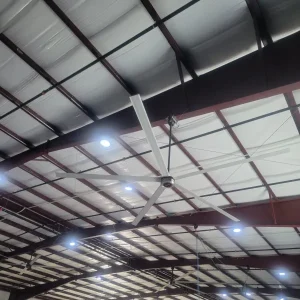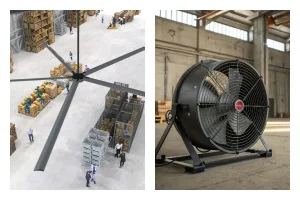Factories, sports halls, and large warehouses often struggle with intense heat and stagnant air. This problem can spike your électricité expenses while making workers uncomfortable and reducing productivity. The good news? By choosing an ventilateur industriel specifically designed to move a lot of air at low speeds, you can transform the climate in your space, slash power bills, and boost morale.
ventilateurs industriels generally do not consume a lot of electricity when you select the right type de ventilateur and operate it efficiently. Many modern models, especially HVLS fans, are designed to move large volumes of air at low speeds, offering significant économies d'énergie while maintaining comfort. Factors like fan size, motor efficiency, and run time all influence how much electricity an ventilateur industriel will use.

Ventilateurs HVLS
When you run an ventilateur industriel, you rely on an electric moteur to generate consistent flux d'air. Ce utilisations des ventilateurs electricity to power the motor, spin pales de ventilateur, and maintain a steady breeze. But how much electricity is consumed, and why does it matter?
Energy usage directly affects energy bills. The more watt your fan draws, the higher the monthly cost of running that fan. In large factories or industrial and commercial environments with multiple fans or extended runtime, every kilowatt-hour adds up quickly, increasing overall energy consumption. That’s why facility managers evaluate electricity usage carefully, hoping to find an industrial fan design that’s powerful yet economical while improving energy efficiency.
It’s easy to assume that more ventilation always equals higher consommation d'énergie, but modern technologies prove otherwise. Some fans—particularly Système de levage à grande vitesse (High Volume Low Speed) fans—deliver robust flux d'air with minimal drain on your power grid. By mixing layers of hot and cold air, they reduce the reliance on pricey air conditioning. Ultimately, balancing your ventilateur en marche hours with the capacity of your ventilateur industriel system can significantly reduce the amount of électricité spent on climate control.
ventilateurs industriels do not always consume more electricity than other methods of cooling. Compared to air conditioners, fans typically use less electricity. A powerful air conditioning system might devour up to 3 or 4 kW per hour of operation—sometimes even more—while a large HVLS or ventilateur axial could run at just a fraction of that. Of course, the exact usage depends on taille du ventilateur, motor rating, speed, and environment.
Using an ventilateur industriel instead of air conditioning can be a façon de refroidir your facility at lower cost. By improving mouvement de l'air, fans help people feel cooler, even if the ambient temperature doesn’t drastically change. This phenomenon is sometimes called the “wind chill effect,” in which flux d'air over the skin enhances evaporative cooling.
Many managers discover they can reduce the amount of electricity used on AC if they run HVLS or ventilateur centrifuge solutions to move air across large footprints. The fan fosters airflow that eliminates hot zones, requiring less intense air conditioning to keep comfort levels stable. Over time, this synergy with Chauffage, ventilation et climatisation can yield substantial cost savings.
For more insights, check out our industrial cooling best practices guide to learn how big fans cut AC usage dramatically.
Different fan types yield different performance characteristics. The main categories you might consider are:
Your building size, occupant density, and existing ventilation structures influence which fan fits best. If you want to push air through long duct routes, a centrifugal fan might be necessary. For broad open floors—like a manufacturing hall or sports facility—larger fans such as HVLS or axial designs typically consume less energy, reducing Consommation d'énergie while maintaining performance. The right industrial fan design can significantly optimize your power usage, cutting out energy waste and improving efficacité énergétique while delivering the airflow you need.
Data Table: Fan Types vs. Power
| Type de ventilateur | Typical Watt Range | Best for |
|---|---|---|
| ventilateur axial | ~200-1500 W | Medium spaces, mid-range flux d'air |
| Ventilateur centrifuge | ~500-3000 W | Higher static pressures, duct systems |
| Ventilateur HVLS | ~100-1000 W (varies) | Large open areas, low-speed coverage |
When people consider ventilateur industriel solutions, they sometimes weigh the differences between ventilateurs sur pied and overhead systems like a ventilateur de plafond. UN piédestal approach is portable and may be cost-effective for smaller areas. But for large, open facilities, a ceiling-based system often offers better coverage with less total energy usage.
Étude de cas
In a 30,000-square-foot gym, installing two overhead HVLS fans replaced plusieurs petits ventilateurs scattered across corners. The result: similar comfort but about 20% less total électricité usage, proving overhead fans can deliver cost savings over multiple pedestal devices.

Pedestal Fans vs Ceiling Fan Systems
A bigger diameter doesn’t always translate to higher electricity consumption if the fan is designed efficiently. For instance, HVLS fans can be quite large but still run at low speeds, using moderate power. Meanwhile, smaller high-speed fans can ramp up wattage usage if forced to run continuously at full tilt.
Industrial fans typically use motors rated in horsepower or watt capacity. High-grade motors often consume less electricity for the same flux d'air output. Checking the motor’s efficiency rating is crucial to gauge how well it converts electricity into mechanical motion.
Running a large fan 24/7 naturally increases your energy bill. However, strategic usage—for instance, only during working hours or high heat periods—keeps costs in check. Some fans have automated controls that adapt vitesse du ventilateur based on temperature or humidity, preventing unnecessary run time.
If your building is well-insulated or uses fans and blowers in synergy with partial climatisation, it may reduce the overall electricity consumption. Properly positioned fans also maximize flux d'air distribution, avoiding wasted energy in corners or obstructions.
At face value, you might think that a single large fan must consume more power than a series of smaller ones. Actually, it’s often the opposite. A well-engineered grand ventilateur industriel can move a beaucoup d'air at low speeds, distributing it across hundreds or thousands of square feet.
Les ventilateurs HVLS sont généralement use less electricity because they rely on a bigger blade span rotating slowly, generating a consistent breeze. By doing so, they lower your reliance on AC or a crowd of smaller pedestal fans, thus decreasing the total draw on your power lines.
For more details, see our HVLS technology advantage guide on how these big fans provide consommation d'énergie benefits.
Choosing the right size fan is crucial. If your fan is too large for the area, you could be overcooling or over-ventilating, leading to wasted power. If it’s too small, you might need multiple fans or higher speeds—also raising electricity usage. Choosing the right size fan ensures balanced coverage with minimal overconsumption.
By adjusting vitesse du ventilateur based on real-time conditions, you reduce the chance of energy waste. For instance, in mild weather, operate the fan at half speed. Many modern industrial fans have built-in controls or variable frequency drives to let you dial in optimum performance.
Dusty or greasy fan blades hamper flux d'air and stress the motor. Simple tasks like cleaning the blades, checking alignment, and lubricating the bearings help keep the fan’s efficiency in top shape. This approach also extends the fan’s life and prevents mechanical breakdowns that lead to bigger bills or downtime.
UN entrepôt typically has high ceilings, minimal insulation, and large open floors. Placing an industrial fan—particularly an HVLS or axial model—can significantly reduce the reliance on AC or other cooling systems. The question remains: How much electricity industrial fans use in these vast spaces?
Cost of running an industrial overhead fan in a typical entrepôt might be less than you expect. Many HVLS fans only require a few hundred watts to run effectively. If you’re operating them for, say, 10 hours daily, the power usage remains moderate, especially when set against air conditioning systems that can run at thousands of watts (kW) for the same duration.
Working these big fans alongside a partial Chauffage, ventilation et climatisation approach can yield synergy. You can reduce electricity consumption by turning down the AC or using a higher set temperature, while the fan ensures occupant comfort. Over time, you’ll likely see significant cost savings and a well-ventilated environment with less strain on your energy resources.

ventilateur hvls dans un grand entrepôt
Consider the space’s dimensions, occupant density, and processes. Are you dealing with high heat, humidity, or airborne particulates? The more clearly you understand your environment, the easier it is to pick a conception du ventilateur that’s both powerful and efficient.
Look at ventilateur axial contre. ventilateur centrifuge solutions, or consider advanced HVLS styles if your facility is large and open. Evaluate the motor watt rating, the typical flux d'air (CFM), and the recommended coverage area. Don’t forget to factor in usage patterns—if your facility needs around-the-clock ventilation, you want a system proven for 24/7 operation.
Work with a fabricant de ventilateurs like HVLS Fans Manufacturing who can guide you in selecting the right industrial fan. We analyze each building’s layout, taille du ventilateur, and performance goals to match you with an ventilateur industriel that’ll deliver effective flux d'air at minimal électricité usage. This is where choosing the right system can lead to big differences in économies de coûts.
Many building managers face escalating electricity costs from multiple pedestal fans or heavy AC usage.Our HVLS fan solutions significantly cut power draw while maintaining comfort.Picture employees enjoying a stable breeze with minimal cost. That means better morale and fewer complaints about scorching conditions. Contact HVLS Fans Manufacturing for custom guidance on picking a type d'industrie fan that meets your distinct layout and operational demands.
Yes, industrial fans often yield a strong return on investment. They consume moderate amounts of électricité, reduce the load on your cooling systems, and enhance occupant well-being. Over the course of several months or years, these benefits easily offset the upfront costs. Combined with regular maintenance and strategic usage, your industrial fan can deliver stable comfort while cutting unnecessary consommation d'énergie.
(A short table: Approx. monthly cost for a 1 kW fan running 8 hours/day)
| kW | Hours/Day | Cost per kWh ($0.12) | Monthly Cost |
|---|---|---|---|
| 1 kW | 8 | $0.12 | ~ $28.80 |
| 2 kW | 8 | $0.12 | ~ $57.60 |
(Note: Figures are approximate; real costs vary by region and electricity rates.)
For more insight on ventilateur industriel strategies and selecting the best solution for your facility, explore these resources:
At HVLS Fans Manufacturing, we serve factories, commercial buildings, centres sportifs, gymnases, écoles, et entrepôts worldwide, delivering advanced ventilateurs industriels that keep your environment comfortable while minimizing électricité usage. Ready to talk about your facility’s cooling needs? Contactez-nous maintenant to learn how our HVLS-based solutions can help you save on energy, reduce operational headaches, and maintain a healthier working environment.

Salut, je suis Michael Danielsson, PDG de Vindus Fans, avec plus de 15 ans d'expérience dans le secteur de l'ingénierie et de la conception. Je suis ici pour partager ce que j'ai appris. Si vous avez des questions, n'hésitez pas à me contacter à tout moment. Grandissons ensemble !